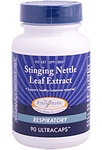| |
Stinging nettle |
|
|
Nettle is a member of the Urticaceae family, which includes as many as 500 species worldwide. The most prominent member of the genus is the Stinging nettle Urtica dioica, native to Europe, Asia, and North America. Stinging nettle is the name given to common nettle, garden nettle, and hybrids of these two plants. Stinging nettle grows well in nitrogen-rich soil, blooms between June and September, and reaches nearly 3 feet high. Leaves are egg-shaped to lanceolate in outline with serrated or toothed leaf margins. Mature leaves are mostly without hairs, except for the long hairs capable of 'stinging' humans that occur on the lower leaf surface. Younger leaves usually have both short hairs and the longer 'stinging' hairs on the upper leaf surfaces. Both the leaves and the stems are covered with brittle, hollow, silky hairs that contain formic acid as a defence against grazing animals. The hairs and spines on the leaves and stems of this weed release formic acid when touched, which gives a burning or stinging sensation to humans. |
| |
Active constituents of stinging nettle |
|
| Stinging nettle is rich in chlorophyll, phosphates, ormic acid, histamine, volatile and resinous acids, tannins, glucoquinine, iron, calcium, potassium, silica, vitamin C, vitamin A, and vitamin E. The water-soluble polysaccharides in nettle stimulate the immune system, and large protein-sugar molecules known as lectins. The flavonoids and potassium in nettle leaves are responsible for their diuretic action. Root preparations are used to relieve some of the symptoms of BPH. |
| |
Medicinal uses and health benefits of stinging nettle |
|
Nettle has astringent, expectorant, galactagogue (milk producing), tonic, anti-inflammatory, hemostatic, and diuretic properties. Stinging nettle has been used for hundreds of years to treat rheumatism, eczema, arthritis, gout, and anemia. Stinging nettle is very effective in treating benign prostatic hyperplasia (BPH), and urinary tract infections. An infusion of the nettle leaves may be used for inflammatory diseases of the lower urinary tract. Nettle may also be effective for treating certain individuals with allergic rhinitis (hay fever). Its diuretic action helps the body to eliminate urea and other waste products and prevents fluid retention. Nettle's expectorant properties have been beneficial for coughs and have been used to expel phlegm from the lungs and stomach. Nettle has a strong astringent action which helps to draw body tissues together and control bleeding. Nettle leaf is used in a simple infusion as a tonic decoction to cleanse the blood. Nettle is also used as a specific for treating cases of childhood eczema; it's especially useful for nervous eczema. Nettle leaves contain iron and vitamin C, being used for treating anemia and poor circulation. |
| |
Dosage and administration of stinging nettle |
|
| Stinging nettle is available as dried leaf, as tea, and as root tincture (a tincture is a solution of the herb in alcohol). Stinging nettle can also be purchased in capsule form. The usual daily dosage is 4 to 6 grams (about 3 to 41/2 teaspoonfuls). A tea may be made by soaking 3 or 4 teaspoons of dried nettle root in about 6 ounces of boiling water for 10 minutes, and then strain. For urinary tract infections, drink several cups of nettle leaf tea daily. For BPH, 120 mg of a concentrated root extract in capsules can be taken two times per day. For external use, apply an alcohol solution (tincture). |
| |
Side effects, precautions, interactions |
|
Stinging nettle product is considered quite safe at commonly recommended dosages. Occasional side effects include mild stomach upset, fluid retention, and hives (mainly from topical use). Nettle should not be used by pregnant women, individuals with heart failure, and those with kidney diseases. Nettle has a diuretic effect and should not be taken in combination with other diuretic medications. |
|
|
|
|
 Stinging Nettle Leaf Extract is standardized to contain 1% silicic acid for optimum benefits. Stinging nettle has been appreciated for its unique advantages since ancient times and is one of the most widely used herbs throughout Europe. Click here for more information.
Stinging Nettle Leaf Extract is standardized to contain 1% silicic acid for optimum benefits. Stinging nettle has been appreciated for its unique advantages since ancient times and is one of the most widely used herbs throughout Europe. Click here for more information.